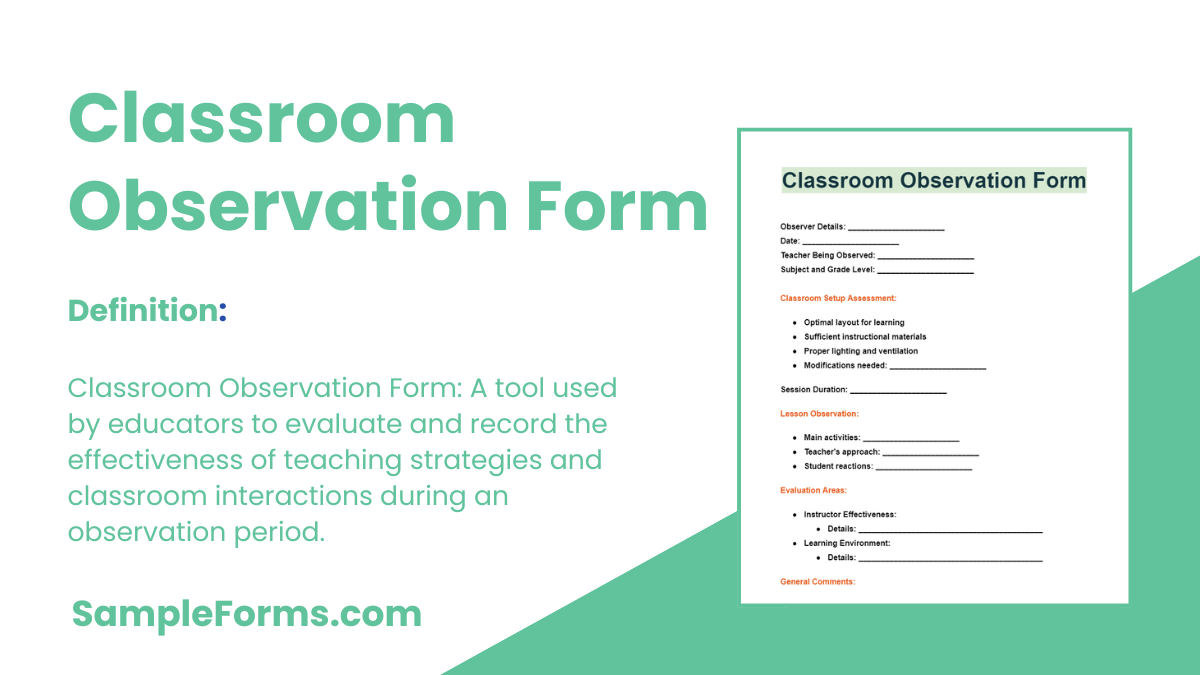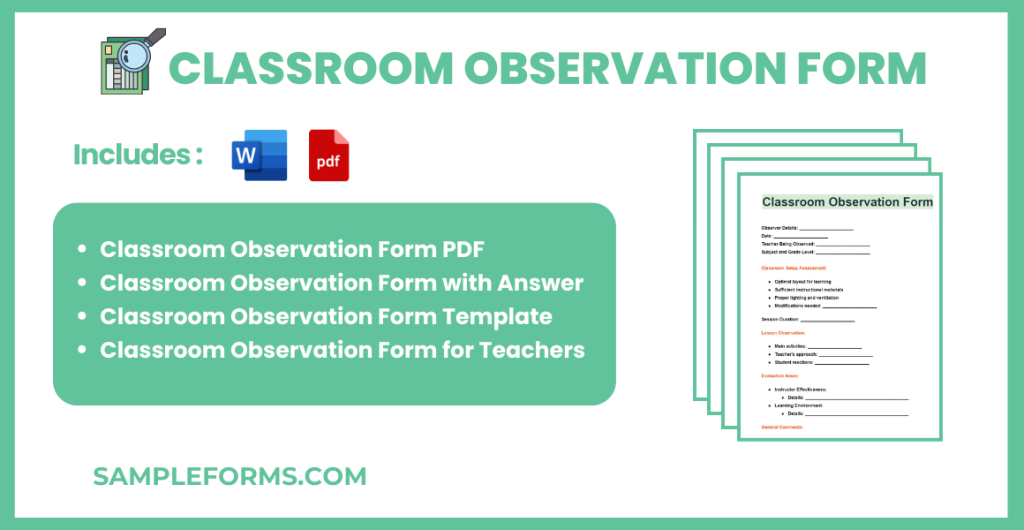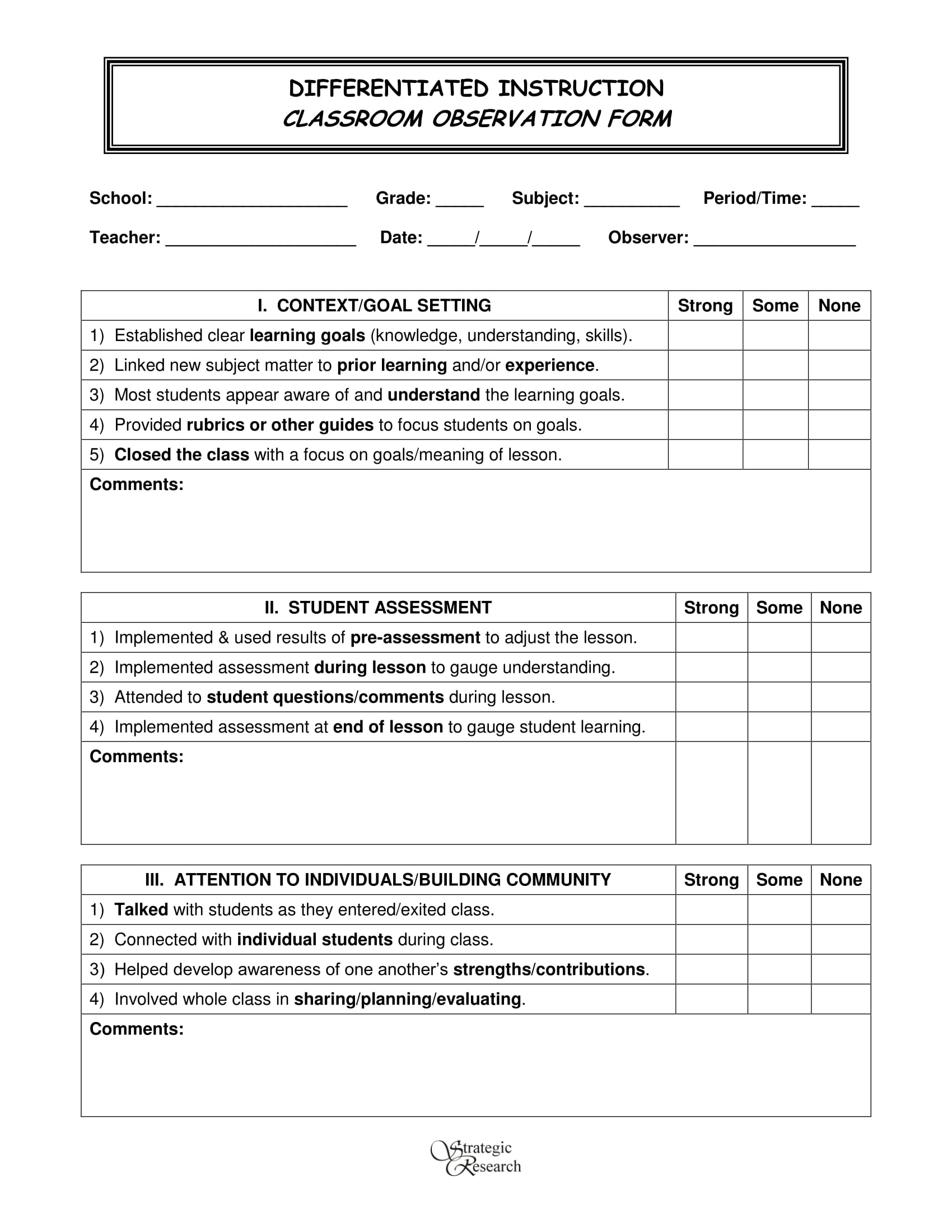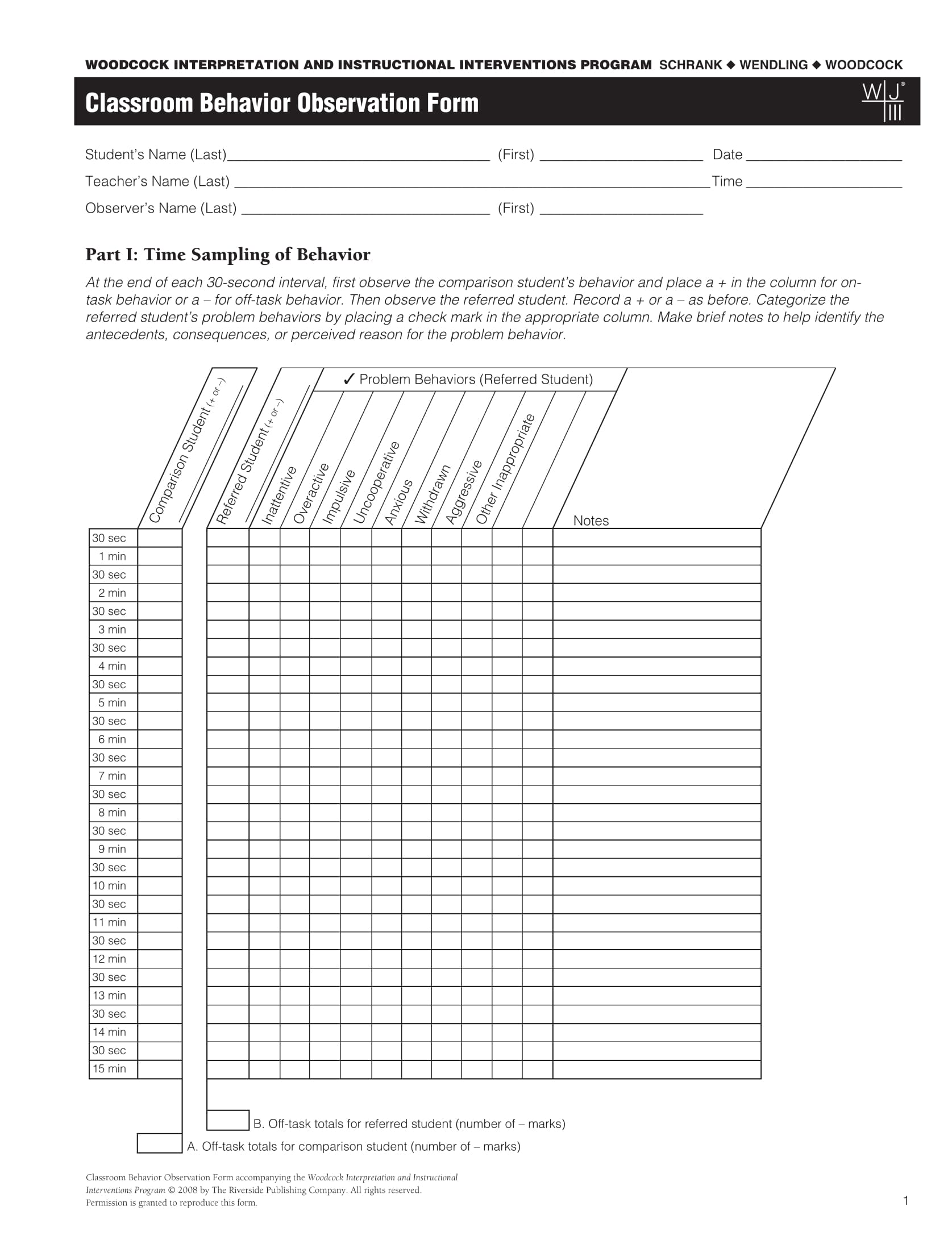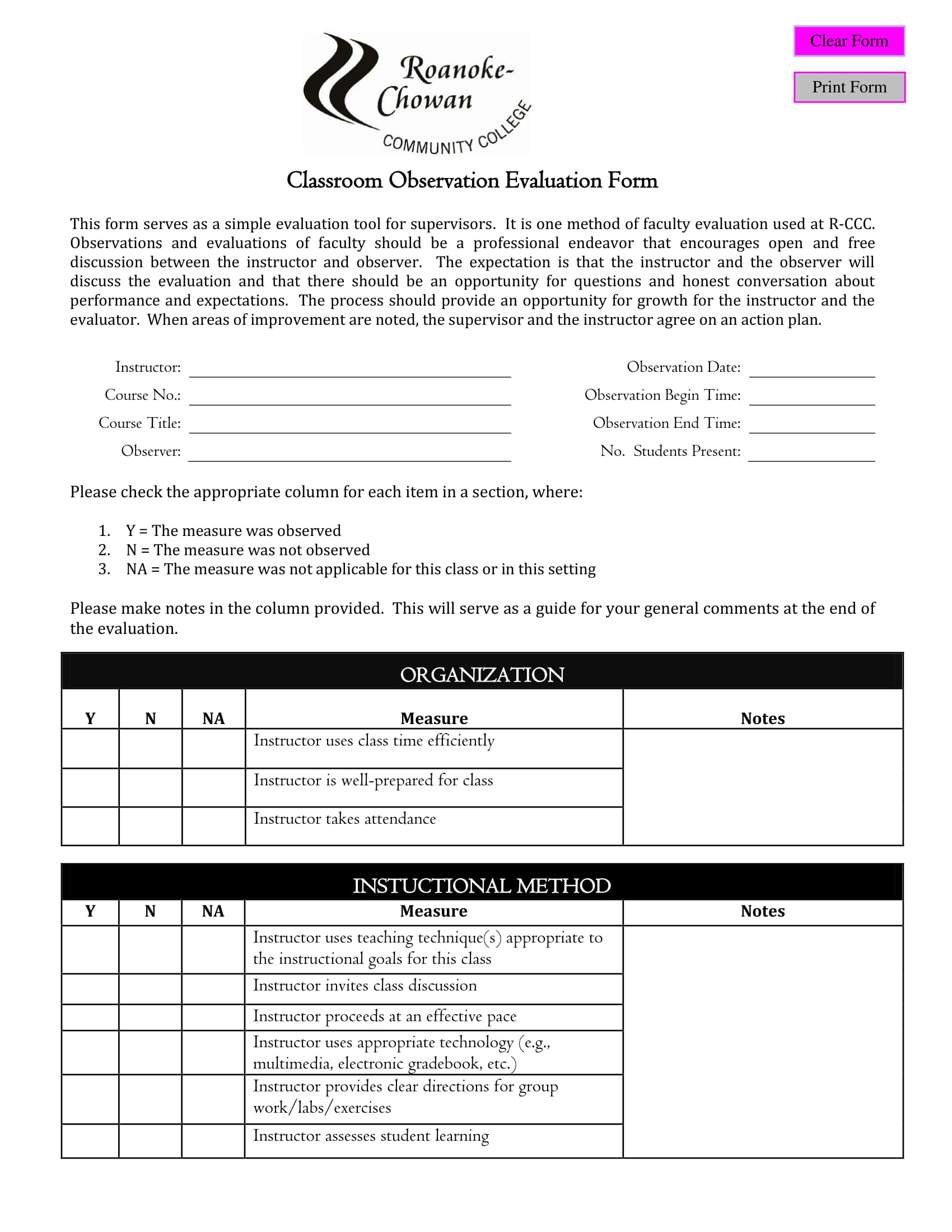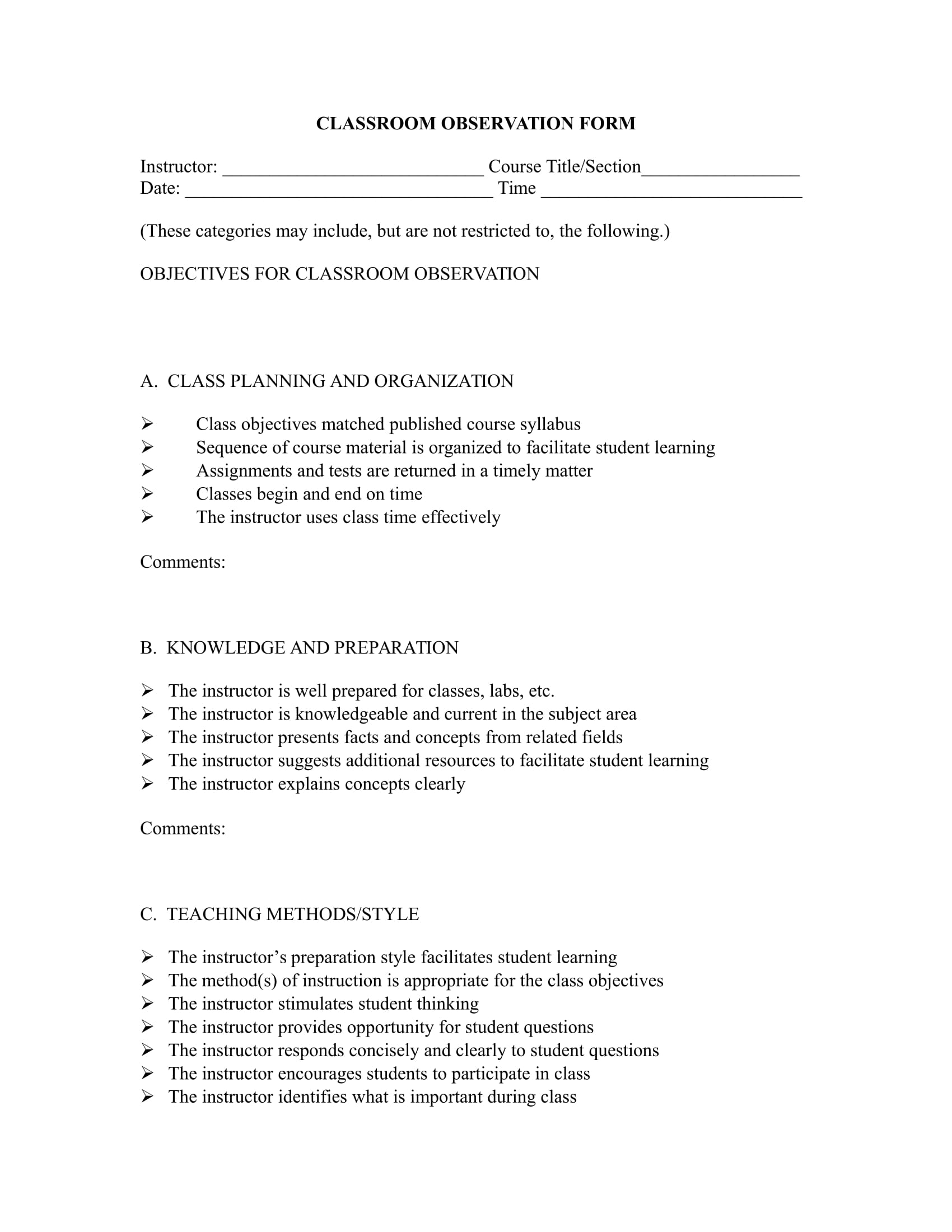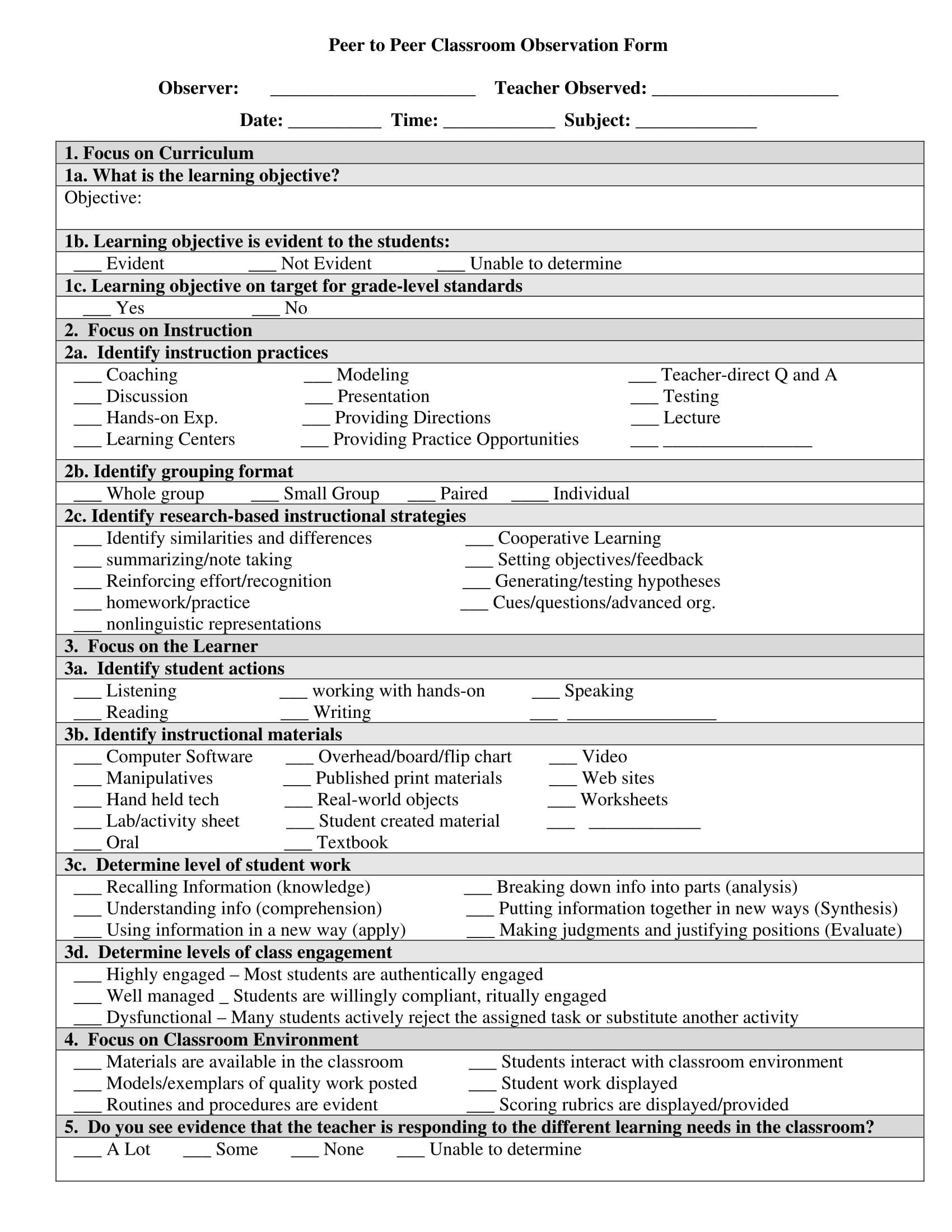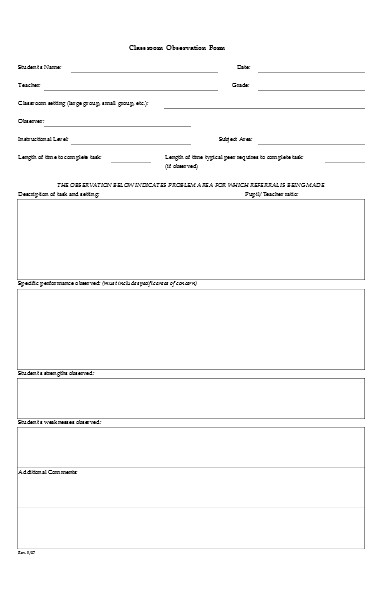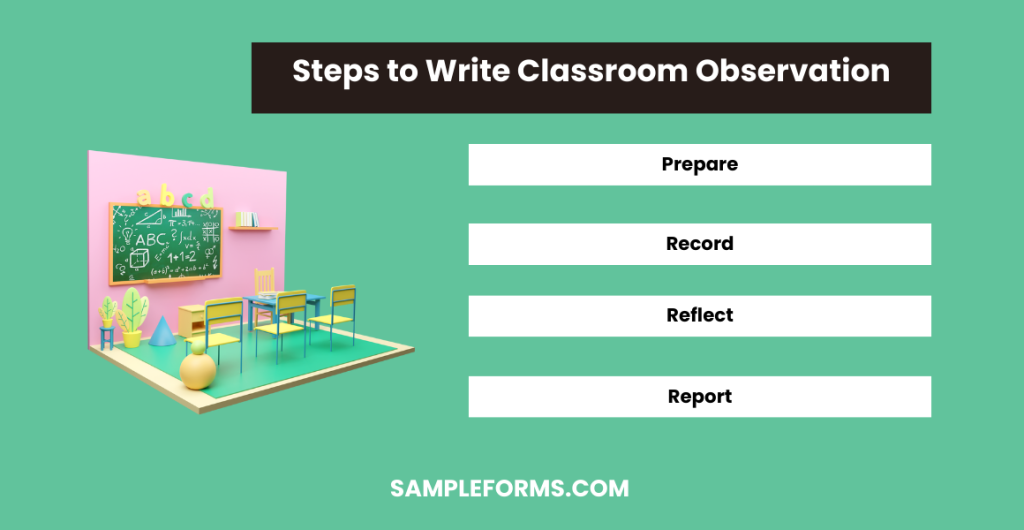The Classroom Observation Form is a vital tool for educators aiming to improve teaching effectiveness. This guide includes detailed examples and instructions on how to utilize the Observation Feedback Form and Fillable Form to assess and enhance instructional practices efficiently. The observation process typically covers various components such as instructional strategies, classroom management, student engagement, and the use of educational resources. By providing structured feedback through these forms, schools aim to foster professional growth among teachers and ultimately improve educational outcomes for students.
Download Classroom Observation Form Bundle
What is a Classroom Observation Form?
A Classroom Observation Form is a document used by educational administrators and peers to assess and record the effectiveness of teaching methods and classroom interactions. The form is designed to guide observers in evaluating specific aspects of the teaching process, such as lesson clarity, student participation, and behavior management. This systematic approach helps in providing constructive feedback to teachers, facilitating professional development, and enhancing instructional quality. Such forms are pivotal in educational settings striving for excellence and continuous improvement.
Classroom Observation Form Format
1. Teacher Information:
- Name: [Teacher’s Name]
- Grade/Subject: [Grade/Subject]
2. Observation Details:
- Date of Observation: [Date]
- Observer: [Observer’s Name]
- Focus Areas: [Areas of Focus]
3. Classroom Environment:
- Engagement Level: [High/Medium/Low]
- Classroom Management: [Effective/Needs Improvement]
4. Instructional Practices:
- Lesson Clarity: [Clear/Confusing]
- Differentiation: [Present/Not Present]
5. Feedback and Recommendations:
- Strengths: [Areas of Strength]
- Areas for Improvement: [Suggestions for Improvement]
Classroom Observation Form PDF
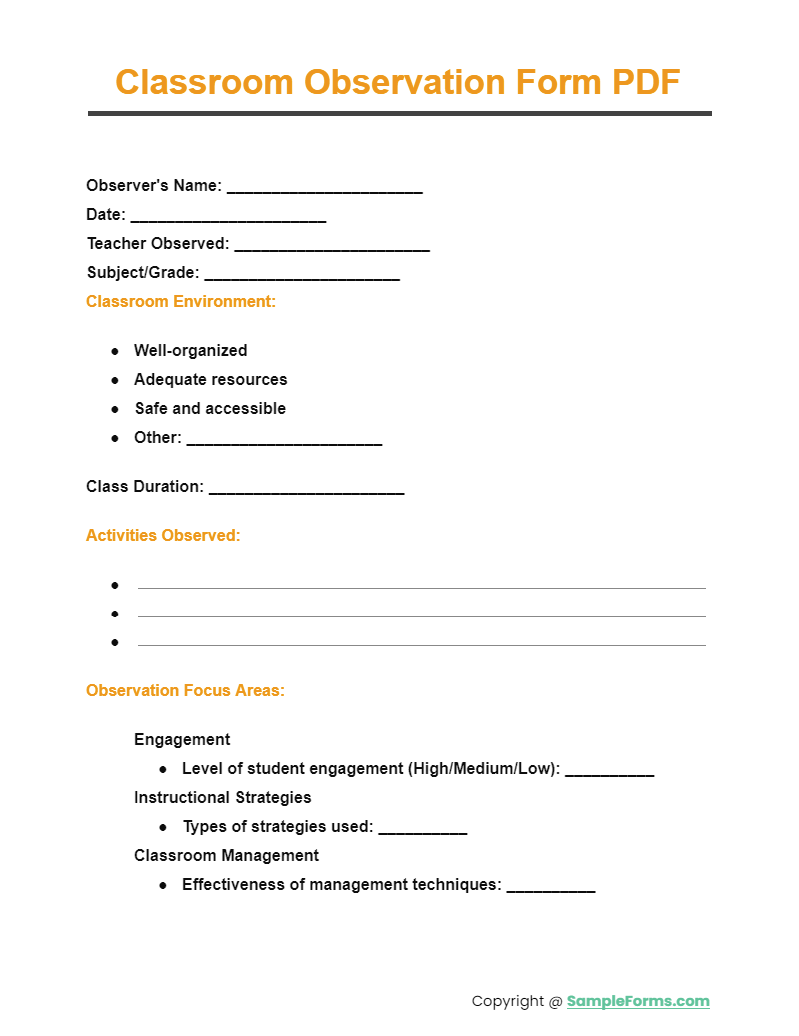
Download a ready-to-use Classroom Observation Form PDF, designed to streamline the observation process in educational settings, integrating elements from the Preschool Observation Form.
Classroom Observation Form with Answer
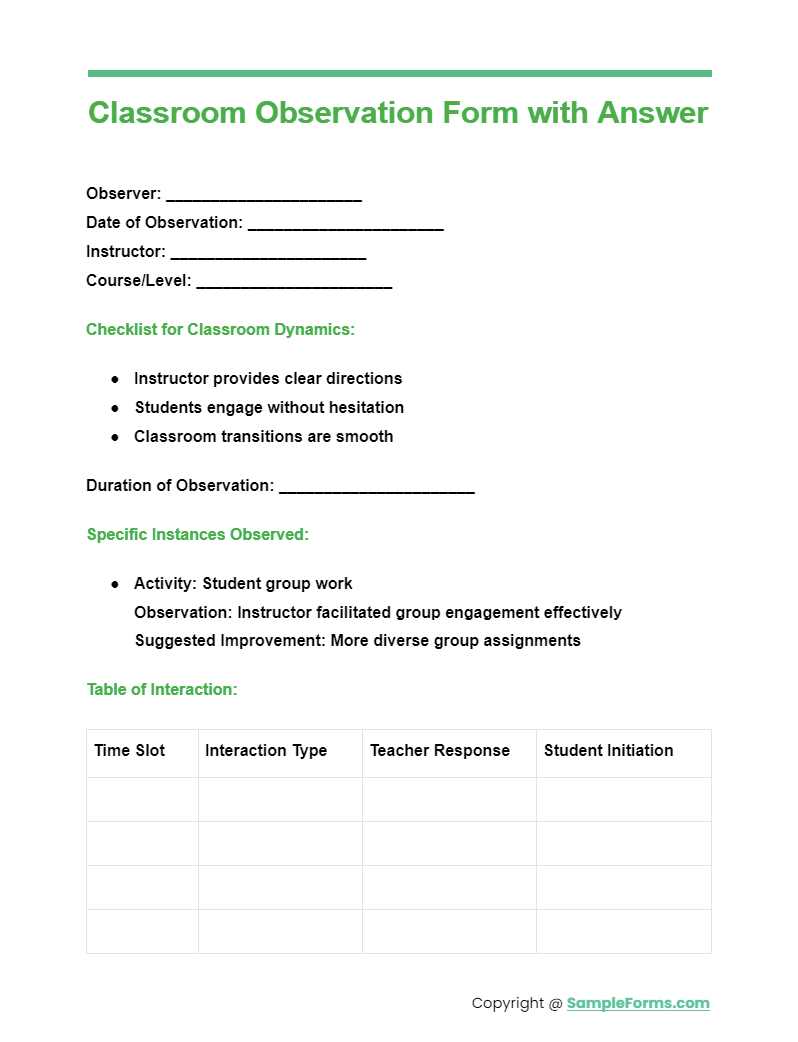
Utilize our Classroom Observation Form with Answer to provide immediate feedback and actionable insights, enhancing the application of the Job Safety Observation Form in educational environments.
Classroom Observation Form Template
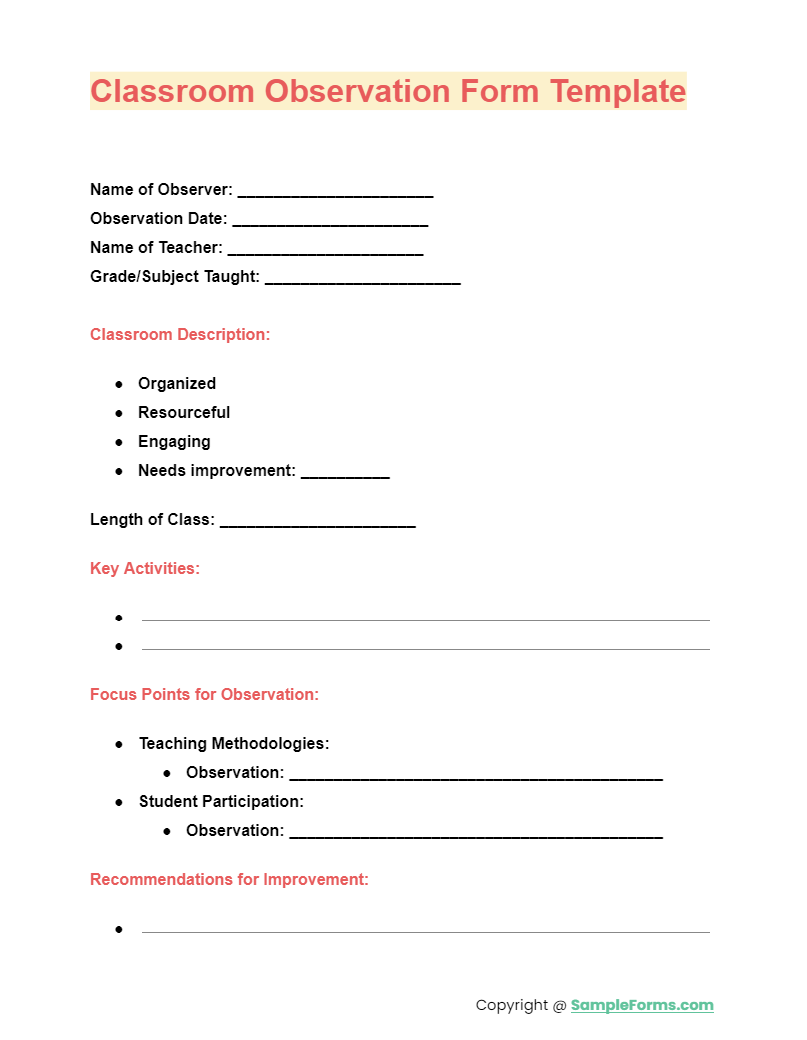
Access customizable Classroom Observation Form Templates that help effectively assess and improve teaching practices, incorporating structured feedback similar to a Student Observation Form.
Classroom Observation Form for Teachers

More Classroom Observation Form Samples
Classroom Observation Form Sample
Classroom Behavior Observation Form
Classroom Observation Evaluation Form
Classroom Observation Form in DOC
Peer to Peer Classroom Observation Form
General Classroom Observation Form
How do you write an observation in the classroom?
- Prepare: Familiarize yourself with the Behavior Observation Form and know what behaviors to note.
- Record: Document observations objectively, noting specific behaviors and interactions.
- Reflect: Analyze the data to identify patterns or areas for improvement.
- Report: Summarize your findings, providing clear and actionable feedback. You may also see Student Action Form
What are the three types of classroom observation?

- Formative Observation: Uses tools like the Child Care Observation Form to provide feedback and support teacher development.
- Summative Observation: Involves formal evaluation of teacher performance.
- Peer Observation: Encourages professional growth through collegial feedback, incorporating aspects of the Employee Observation Form.
What important things should you remember when making observations?
- Consistency: Use a standardized Child Observation Form to maintain uniformity in data collection.
- Objectivity: Record facts without personal bias.
- Confidentiality: Keep the information secure and private.
- Detail: Note specific examples that support your observations. You may also see Student Self-Assessment Form
What is a checklist for observation?
- Develop: Create a checklist that includes key criteria relevant to the observation goals.
- Structure: Organize items logically, perhaps segmenting by period or activity.
- Use: Apply the checklist during observations to ensure thoroughness, incorporating a Clinical Observation Form where necessary.
- Review: Evaluate and update the checklist regularly to meet evolving educational goals. You may also see Student Survey Form
What should teacher do during observation?
- Engage: Continue with normal teaching practices without altering behavior due to being observed.
- Interact: Demonstrate interaction with students as usual.
- Implement: Use strategies from the Lesson Feedback Form to showcase effective teaching practices.
- Reflect: After the observation, reflect on feedback for professional growth. You may also see Student Loan Agreement Form
What is the purpose of the classroom observation tool?
- Assessment: To evaluate teaching methods and student engagement, utilizing tools like the Coach Observation Form.
- Improvement: To identify areas for professional development and enhance educational quality.
- Feedback: To provide constructive criticism and positive reinforcement to educators.
- Documentation: To maintain records of teaching progress and areas addressed. You may also see Student Assessment Form
How do I fill out a time observation form?
- Identify: Determine the specific activities or periods to be monitored.
- Record: Note the start and end times of each activity, using precise timing.
- Analyze: Look for trends in how time is spent during class.
- Feedback: Use the data collected to provide feedback or make adjustments to teaching practices. You may also see Student Transfer Form
How to Create a Classroom Observation Form
- Creating a classroom observation form is easy especially with the usage of computers and software tools. However, if you prefer to create your own document from scratch, you must first research and gather the classroom standards of your school or state. This is to aid you in creating the table for your evaluation which should be categorized depending on the relativity of the standards unto one another. After this, you can begin arranging the sections of your form beginning from the name of your school and its address. You may also see Student Report Form
- The bottom of your header should have spaces that are intended for the general information of the subject being observed such as the class schedule and the name of the assigned teacher. Along with these details is the date of when the observation was done as well as a space for the observer’s name. You may also see Student Statement Form
- Then, the table for the standards and its rating scales should be placed alongside each other. Since the standards are grouped into relating categories, a comment section should be incorporated at the end of each group to separate and sum up the category’s ratings. You may also see Student Complaint Form
- Survey questionnaires that relate to the classroom observation procedure can also be included to acquire better explanations and suggestions from the observer. However, the questionnaires must be after the tables of the standards’ ratings. You may also see Student Contact Form
What is the most common observation?
The most common observation in classrooms typically involves assessing teaching strategies and student engagement, often documented using a Class Evaluation Form.
What should observation for a beginner teacher include?
Observations for beginner teachers should focus on classroom management, lesson delivery, and student engagement, supported by feedback through a Hazard Observation Form.
How long is a class observation?
A class observation typically lasts for one full class period or session, which can vary from 45 to 90 minutes, ensuring comprehensive assessment and documentation on a Student Progress Report Form.
What is a good class observation score?
A good class observation score effectively reflects high levels of teacher engagement, innovative teaching methods, and positive student interactions, often quantified via a Student Information Form.
How do you take notes in a teacher observation?
During teacher observation, take notes focusing on specific teaching practices, student reactions, and the educational environment, ideally noted in an organized manner like a Student Registration Form.
How is classroom observation done?
Classroom observation is conducted by watching and noting teacher-student interactions, instructional methods, and classroom environment, using structured tools such as a Student Clearance Form for systematic evaluation.
What is a good sentence for observation?
“A good sentence for observation succinctly captures specific, objective details about the subject or situation, similar to entries in a Student Affidavit Form.”
In conclusion, the Classroom Observation Form serves as an essential tool for educational improvement, providing structured feedback and actionable insights. It’s an integral part of the process, similar in purpose to a Student Reimbursement Form, supporting continuous professional development.
Related Posts
-
FREE 3+ Hotel Feedback Evaluation Forms in PDF | MS Word
-
FREE 16+ Customer and Guest Feedback Forms in PDF | MS Word
-
FREE 32+ Different Formats for Feedback Forms in PDF | Ms Word | Excel
-
FREE 7+ Insurance Customer Feedback Samples in PDF
-
FREE 5+ Automobile Buyer Feedback Samples in PDF
-
FREE 11+ Property Feedback Forms in PDF | Ms word
-
Nursing Feedback Form
-
Form for 360 Degree Feedback
-
FREE 10+ Feedback Forms Aimed at Doctors | PDF
-
FREE 11+ Demo Feedback Forms in PDF | MS Word
-
FREE 11+ Exam and Test Feedback Forms in PDF | Ms Word
-
FREE 10+ Medical Feedback Forms in PDF
-
Induction Feedback Form
-
Coaching Feedback Form
-
Form for Lecture Feedback
